
The Gods of Japanese Myths and Legends
Gods Old and New: Different Types of Japanese Deities
Guide to Japan Culture Lifestyle History- English
- 日本語
- 简体字
- 繁體字
- Français
- Español
- العربية
- Русский
Kami and Nature
Kami, the deities and spirits of Japan’s native Shintō belief, dwell in a broad variety of settings. Traditionally, they are seen as inhabiting nature, from earthly homes like trees and rocks to celestial bodies like the sun and moon. The presence of a shimenawa, a special rope with tassels and zig-zagging white streamers, denotes the sanctity or purity of an object or place. These are often found strung on sacred rock formations and venerated old trees inside Shintō shrines. Mountains are also considered divine, such as Mount Fuji, Japan’s best-known sacred peak.
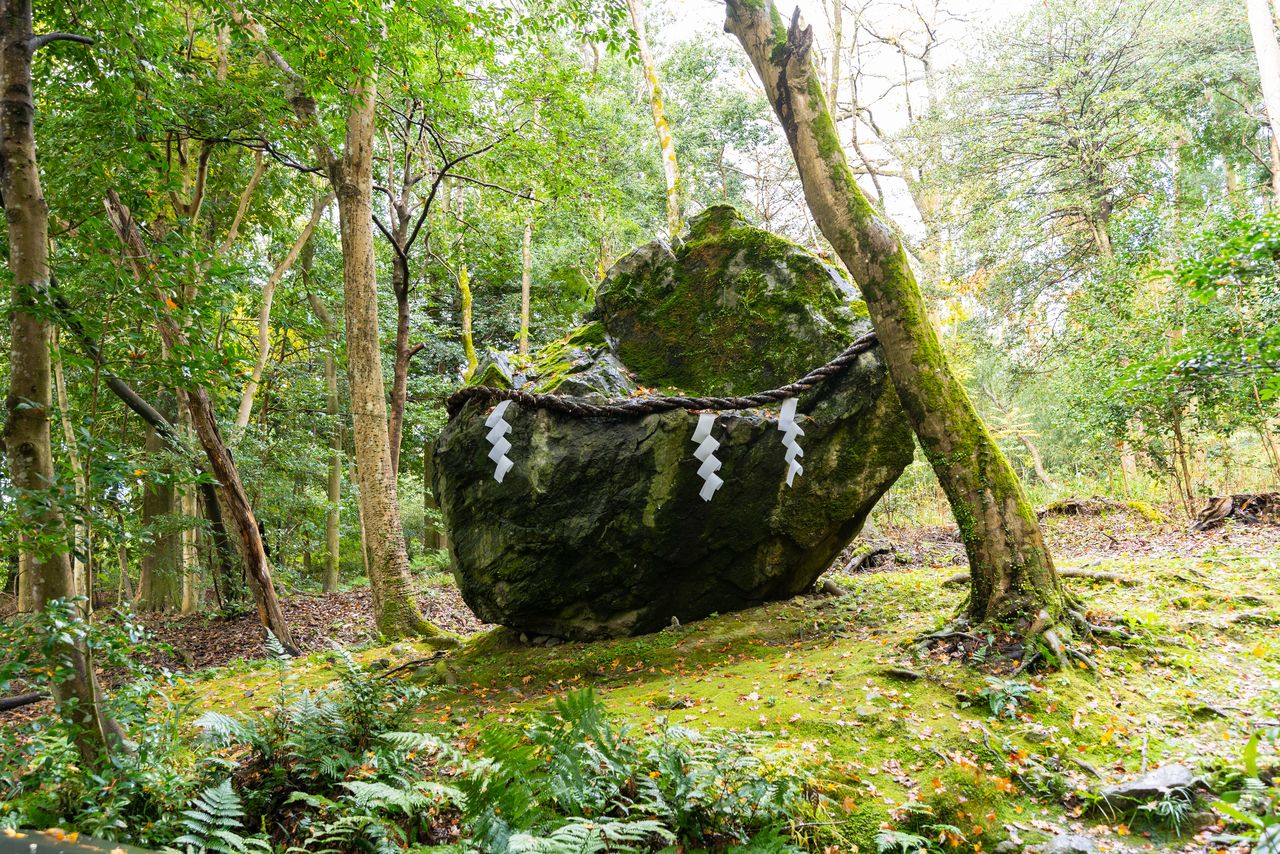
A shimenawa marks a sacred rock (iwakura) at the Izumo Daijingū in Kyoto Prefecture. (© Kazenotami/Pixta)
Nature worship is believed to have been practiced in Japan since prehistoric times, but little physical evidence has survived the ages to indicate the forms that it took. However, with the beginning of rice cultivation in Japan during the Yayoi period (c. 300 BC–250 AD), it is believed that people prayed to the different aspects of nature around them—the sun, rain, trees, and mountains—entreating these forces to provide a bountiful harvest. The earliest evidence of the practice is from sites like the Ōmiwa Shrine on Mount Miwa in Nara Prefecture, one of Japan’s oldest Shintō shrines. There, sacred objects such as comma-shaped stones called magatama dating from the fourth to sixth centuries CE were discovered buried beneath large boulders, indicating ritual worship of the rock formations.
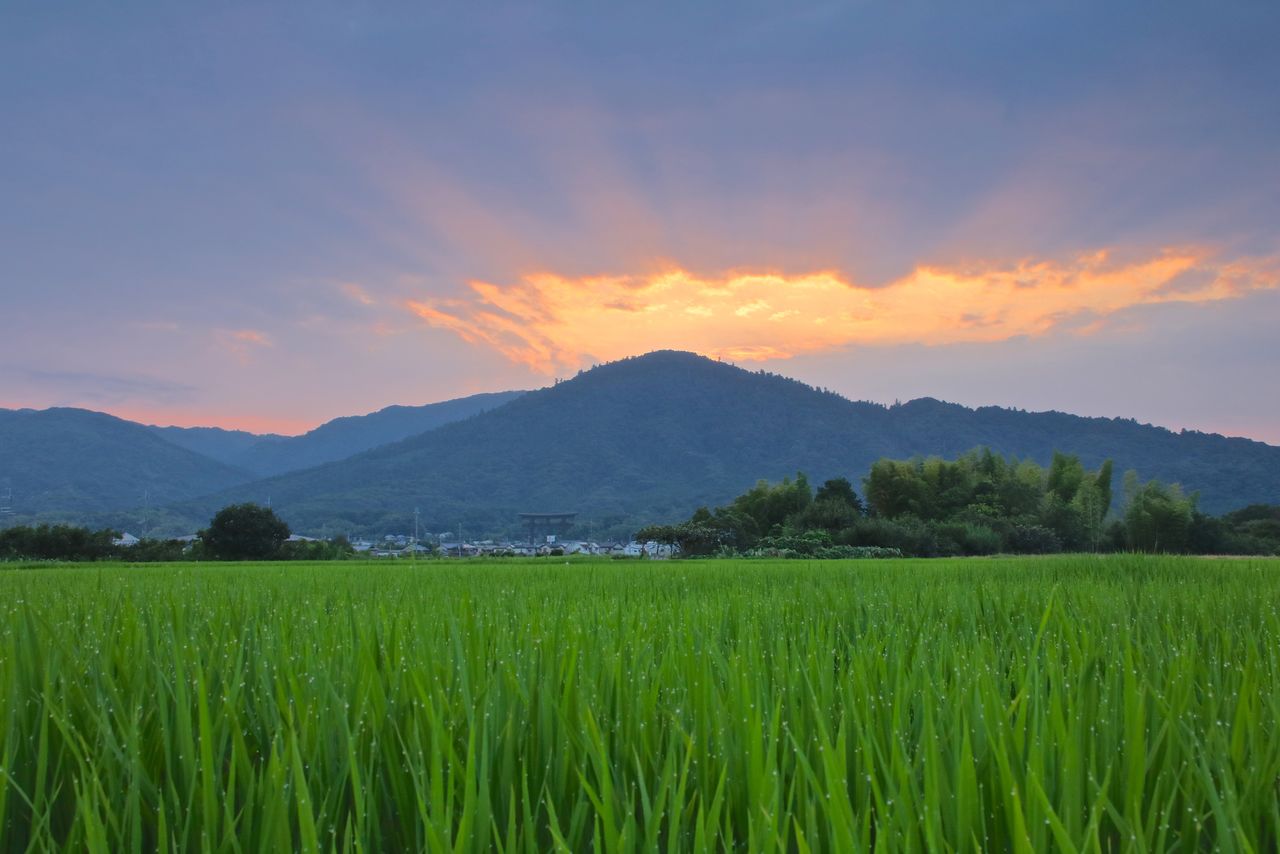
Mount Miwa was the most sacred mountain (shintaisan) in the ancient province of Yamato. (© Pixta)
In time, natural phenomena were attributed human forms, transforming them into the kami that appear in Japanese mythology. These were joined by folk deities and other types of divine spirits that arose over the ages to form the richly assorted Japanese pantheon.
Gods from Myths
There are some 80,000 Shintō shrines in Japan. The majority of these enshrine kami appearing in the early eighth century histories Kojiki and Nihon shoki and various ancient accounts (fudoki) from different provinces that record the creation myths and other legends establishing the divine lineage of Japanese emperors. These documents were compiled during a transformative period in Japanese history, when the government wanted to reinforce the power of the state with histories legitimizing its authority. Looking beyond this political and historical backdrop, though, the tales vividly reveal the customs, culture, and worldview of the Japanese of ancient times.
Among the events detailed in the works, the birth of the sun goddess Amaterasu is of particular significance.
Amaterasu
In Japanese mythology, the male deity Izanagi and female deity Izanami create the islands and environs of Japan, an act that the Kojiki, compiled in 712, describes as kuniumi, or “birth of the land.” The divine couple, standing atop a floating bridge spanning the heavens, first stir the churning brine below with a jeweled spear, from the tip of which fall droplets that form an island. They descend to the island and wed, after which they form the other islands of the Japanese archipelago along with the mountains, rivers, plants, and other aspects of the natural world.
This task complete, Izanami gives birth to several children. However, in bringing forth the fire deity Kagutsuchi, she is badly burned and dies. She descends to the land of Yomi, and Izanagi travels there in an attempt to return his bride to the world of the living. Failing in this, he ritually purifies himself (misogi), during which he washes his face and brings forth “three noble children”: Amaterasu from his left eye, Tsukuyomi from his right eye, and Susanoo from his nose. Amaterasu and Susanoo play a central role in what comes next, but for whatever reason, the Kojiki has little else to say about Tsukuyomi.
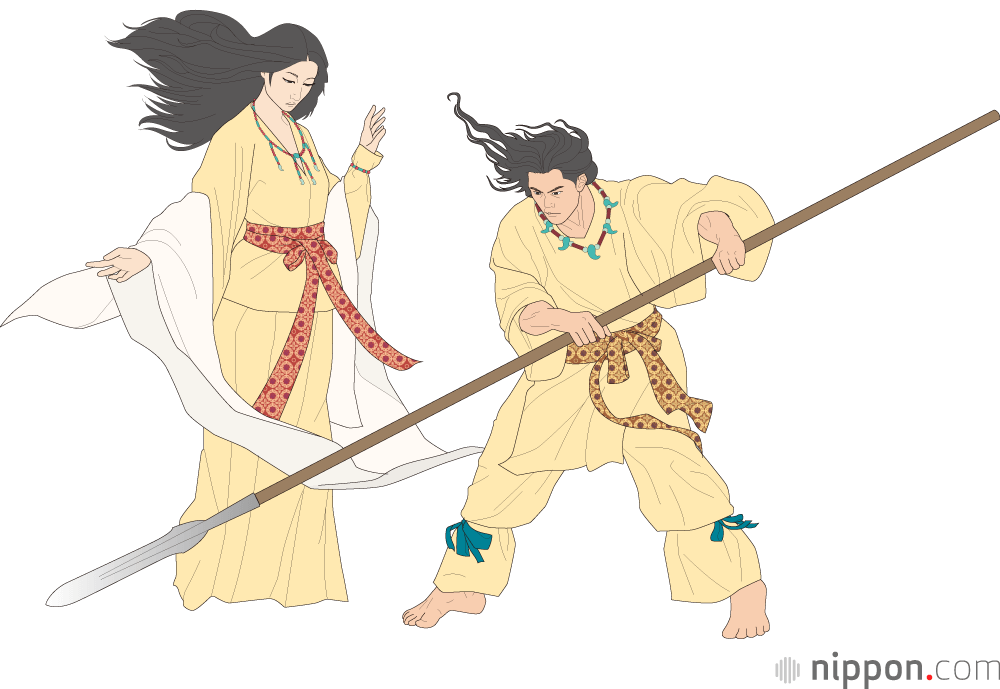
Izanami and Izanagi. (© Satō Tadashi)
The Nihon shoki, compiled in 720, offers a slightly different version of the creation myth, with Izanagi and Izanami conferring together and deciding to create a kami who would rule over the land they had just formed. The text installs Amaterasu from birth as ruler of the plain of high heaven, Takama-no-Hara, and head of the Japanese pantheon. The Kojiki, by comparison, describes Izanagi entrusting Amaterasu as ruler of the heavenly plain.
The arrival of her younger brother Susanoo, an impetuous deity who is cast out of the heavenly realm for shirking his duties and various other heinous acts, presents a challenge to Amaterasu, who sees her peevish sibling as contesting her rule, and arms herself in preparation.
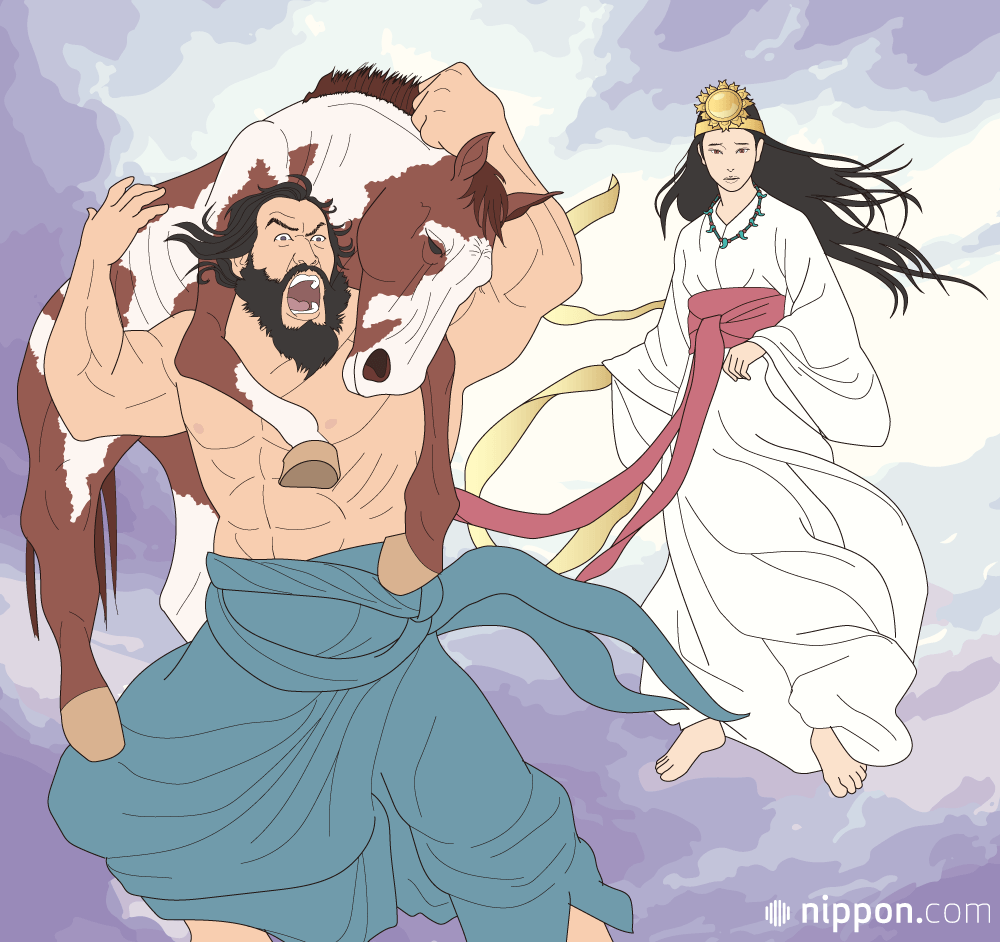
After a raging Susanoo throws a heavenly piebald colt into her weaving hall, Amaterasu takes refuge in a cave. (© Satō Tadashi)
Susanoo assures his sister he has no malicious intent, and after they swear oaths to prove sincerity, he has the two bear children from the possessions of the other. With the sword of Susanoo, Amaterasu brings forth five male deities, and Susanoo produces three daughters from jewels worn by Amaterasu. Having brought forth “graceful maidens,” Susanoo declares victory, and in his triumph, he rampages through Takama-no-Hara, wreaking havoc among the halls and fields and killing the “heavenly weaving maiden.” A frightened Amaterasu seals herself inside the Ama-no-Iwaya, the “heavenly rock-cave,” plunging the world into darkness and calamity.
Bemused, the other kami gather and devise to perform a ritual, in preparation for which they hang a string of magatama beads and a mirror—two of the “three sacred treasures” later passed to successive emperors—from the branches of a sacred sakaki tree. During the rite, the goddess Uzume performs a lewd dance that causes the other deities to burst out in uproarious laughter. Intrigued by the commotion, Amaterasu peers from her cave and sees her reflection in the mirror, to which she slowly approaches and is pulled from her hiding spot, returning light to the world. Susanoo is summarily banished and Amaterasu resumes her place at the head of the heavenly realm.
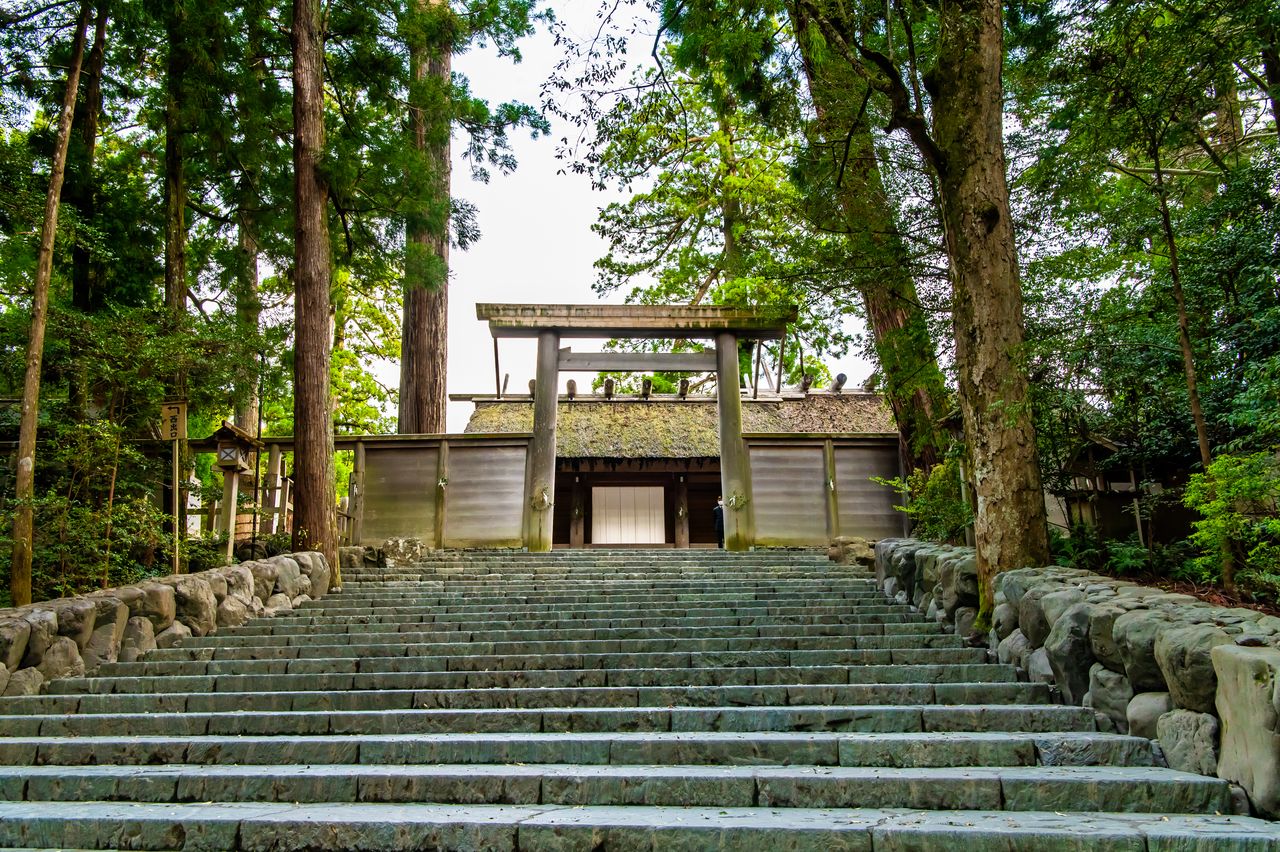
Stone steps leading up to the main shrine building of Ise Jingū, which enshrines Amaterasu. (© Pixta)
Japanese mythology depicts the sun goddess in a very different light than the supreme deities characteristic of monotheistic religions. She is inherently fallible, with her various shortcomings impacting her judgement and behavior. Learning from her trials, she listens to the counsel of other kami. In time, she sends her grandson, the god Ninigi, to earth, and it is the offspring of this deity to whom the Japanese imperial line traces its legendary heritage.
Today, Amaterasu is worshipped at Shintō shrines throughout Japan, most notably at Ise Jingū, the most important of Japan’s multitude of shrines, and the various Shinmei Shrines scattered across the country.
Down to Earth: Gods of Folklore
Joining those exalted deities listed in the Kojiki and Nihon shoki are kami who arose as part of long-practiced folk beliefs. Prominent among these is Ebisu, one of Japan’s shichifukujin, the Seven Gods of Good Fortune. Depicted carrying a rod and holding a large sea bream, he is thought to have originated as a god of fishing.
The term ebisu has long indicated otherness and was commonly used to describe unexpected bounties carried on the waves. In fishing communities, for instance, the term ebisu traditionally referred to carcasses of dolphins, whales, or the bodies of drowning victims that washed ashore. These gruesome discoveries were considered auspicious in that they hinted at changes in the sea currents that would bring bountiful catches.
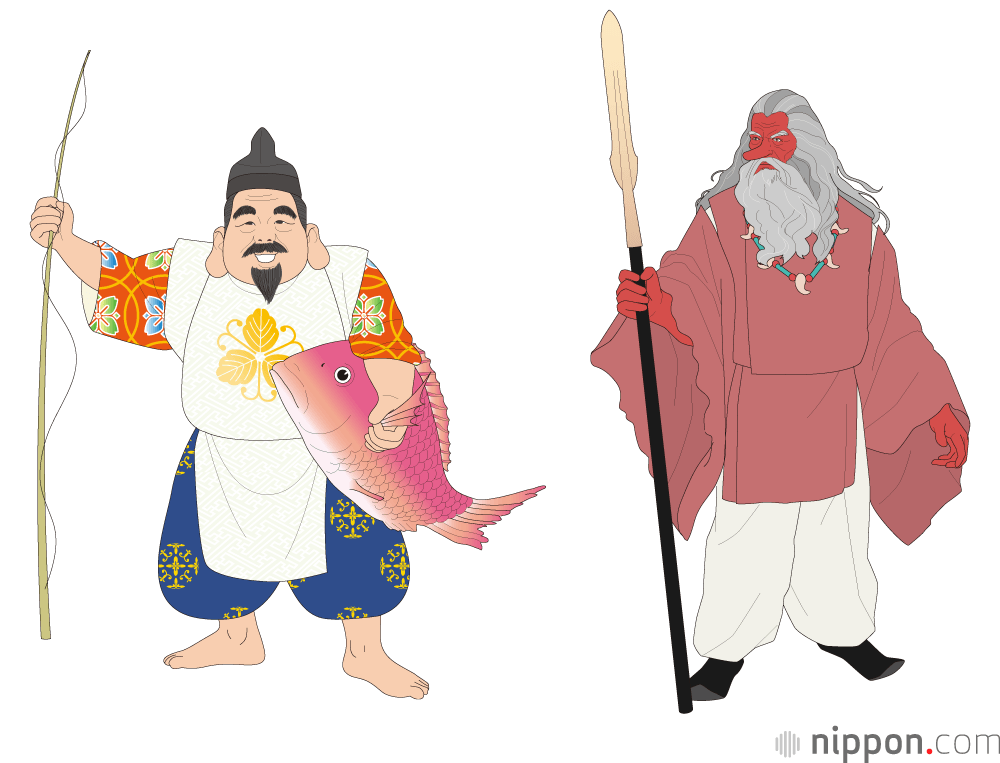
Ebisu with his fishing rod and sea bream, and Sarutahiko with his distinctive long nose. (© Satō Tadashi)
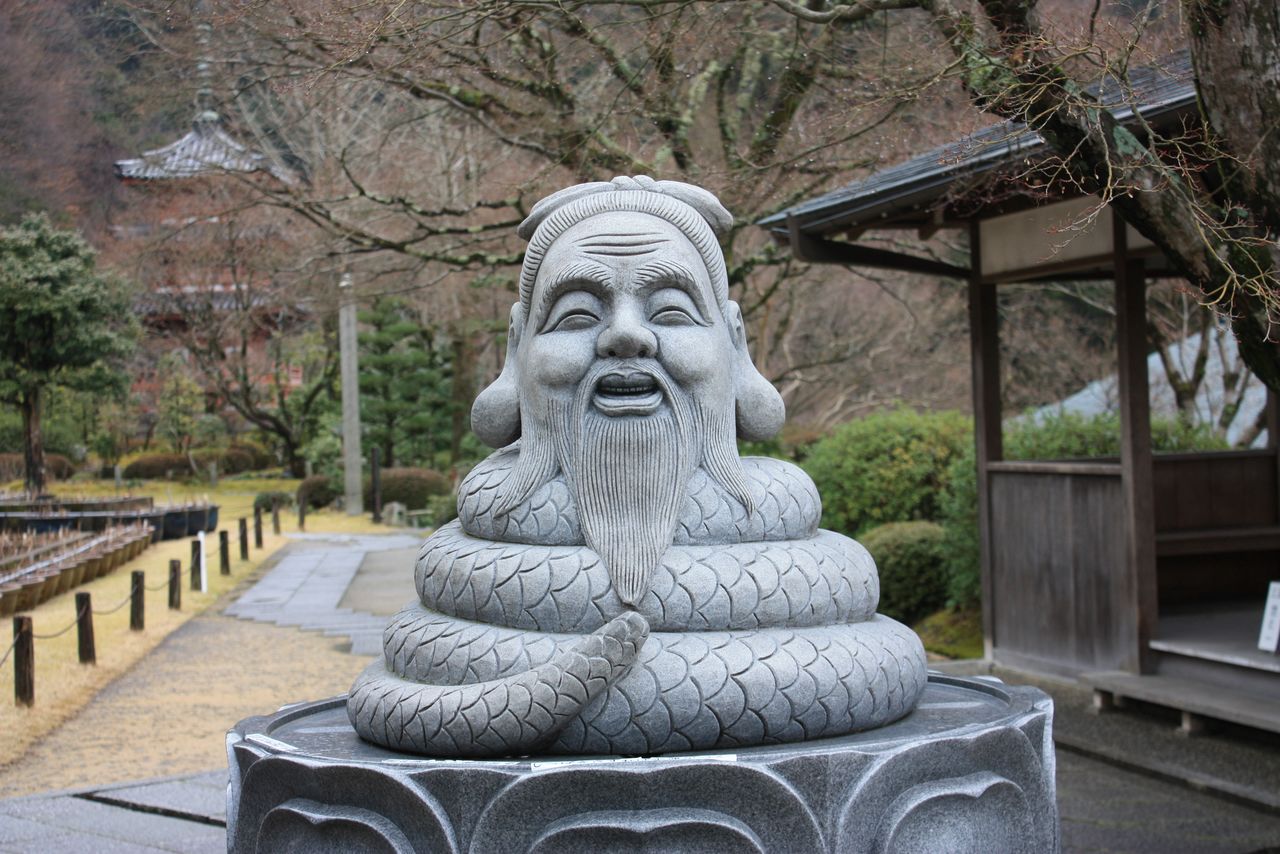
A statue of Ugajin at the Buddhist temple Mimurotoji in Uji, Kyoto Prefecture. (© Pixta)
Although absent from the mythology of the Kojiki and Nihon shoki, Ebisu is associated with Hiruko, the malformed son of Izanagi and Izanami whom the divine couple set afloat in a reed boat shortly after his birth. In fact, Nishinomiya Shrine in Hyōgo Prefecture, the principal shrine to the thousands of sites enshrining Ebisu, holds that the two deities are one and the same.
Other deities originating in folk beliefs include the hearth god Kōjin, the toshigami New Year gods, the god of rice paddies Ta-no-Kami, the god of grains Ugajin (depicted with the body of a snake and the head of a bearded man), and Oshirasama, who is worshipped in the Tōhoku region as the god of silkworms. Like Ebisu, many of these spirits have become associated with kami of Japanese mythology, such as Dōsojin, a deity guarding villages against evil spirits who is identified with Sarutahiko, the guide of Ninigi during his descent to earth. Such connections work in the opposite direction as well. Sarutahiko, who the Nihon shoki depicts as having a very long nose, is thought to be the model for tengu, similarly featured creatures from Japanese legend.
Perhaps the most diffuse deity is Inari-no-Kami, whose shrines, such as the well-known Fushimi Inari Shrine, are recognizable by their rows of vermillion torii gates. Commonly referred to simply as o-inari-san, the kami is worshipped primarily as the god of rice cultivation and commerce.
From Human to Kami
Shintō belief, in contrast to religions that draw clear lines between God and mortals, asserts that kami dwell in all things, allowing for people themselves to become deities. There are a number of historical figures who have come to be worshipped as kami. Preeminent among these is the Heian period courtier Sugawara no Michizane (845–903).
Michizane, a leading court scholar and statesman, rose to prominence in the government, but was undone by rivals who falsely accused him of plotting against the emperor. He was subsequently exiled to Dazaifu, the government headquarters in Kyūshū, and died shortly after. A spate of cataclysms and unfortunate events soon befell Kyoto, including the death of several princes and lightning setting a section of the Imperial Palace ablaze, killing several of those responsible for Michizane’s downfall. These calamities were attributed to Michizane, who was thought to have returned to wreak revenge as an onryō, a type of malicious ghost. To placate his angry spirit, Michizane was posthumously pardoned, deified as Tenjin, and enshrined in the Kitano Tenmangū Shrine in Kyoto.
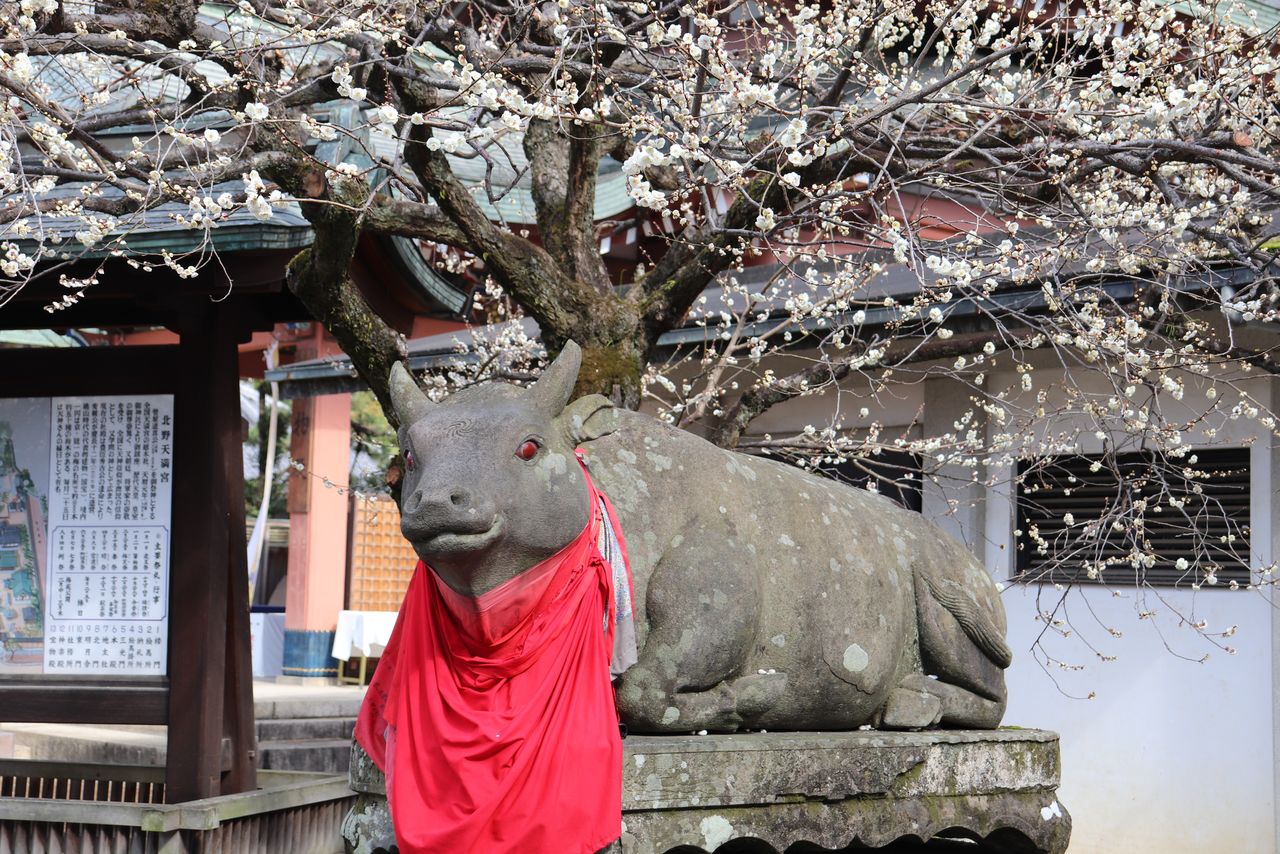
An ox and plum blossoms, symbols of Sugawara no Michizane, on the grounds of Kitano Tenmangū Shrine. (© Pixta)
Worshipped as Tenjin, Michizane in time transformed from a vengeful figure to one revered for his literary works. Today, he is venerated as a god of scholarship, and each year droves of students visit shrines dedicated to Tenjin to pray for success in school entrance exams.
Edo shogunate founder Tokugawa Ieyasu is another human who has risen to the rank of god. Worshipped as Tōshō Daigongen, he is enshrined at the Nikkō Tōshōgū in Tochigi Prefecture.
These are just a few of the deities illustrating the vast range of kami who occupy Japan’s rich and fluid pantheon.
(Originally published in Japanese. Banner image: Amaterasu emerges from her cave. © Satō Tadashi.)
Buddhism kami Kojiki myth Amaterasu shrines and temples Shinto